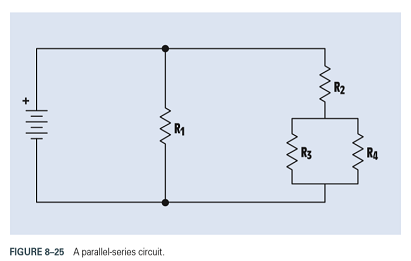
Concept explainers
Find the unknown values in the circuit if the total current is 1.2 A and the resistors have the following values:

FIGURE 8-25 A parallel-series circuit.
Want to see the full answer?
Check out a sample textbook solution
Chapter 8 Solutions
Delmar's Standard Textbook Of Electricity
- Applying star delta conversions:Determine the value of the total resistanceApply a voltage of 12 volts to the circuitDetermine the total current.Determine Voltage Across R14arrow_forwardFor the circuit shown in Figure 1 below, answer the following questions. 1. What is i1 in amperes? Round your answer to 3 decimal places. 2. What is i2 in amperes? Round your answer to 3 decimal places. 3. What is i3 in amperes? Round your answer to 3 decimal places. 4. What is i4 in amperes? Round your answer to 3 decimal places.arrow_forward7. The equivalent total resistance in the circuit in Figure 1 is_ 2200 E=7V- 1000. 4700. 100. 3300 Figure 1 1. 558.90 2. 2160 3. 642.450 4. 82.892 8. The current through the 1002 resistor in the circuit in Figure 1 is_ 1. 84.45mA 2. 70mA 3. 14.89mA 4. 17.51mA 9. The power dissipated by the 3302 resistor in the circuit in Figure 1 isarrow_forward
- Given two batteries: one with voltage V and internal resistance r₁; another with also voltage V and internal resistance r2. Which of the following is true if we connect them in series facing the same direction? O The answer cannot be found on the other choices. O The total voltage will be 2V while the total internal resistance will be r₁ + 12. No voltage will remain while the total internal resistance will be r1 + 2. The total voltage will be V, while the total internal resistance will be r1 + 12.arrow_forwardState Kirchoff's current Law. None of these sum of all powers in a circuit sum of all emfs in a circuit sum of all positive currents is equal to sum of all negative currents. sum of all positive voltages is equal to the sum of all negative voltages taken in orderarrow_forwardUsing nodal analysis, What is the current through the 8 ohm resistor? What is the current through the 2 ohm resistor? What is the current through the 6 ohm resistor? What is the current through the 4 ohm resistor? What is the direction of current through the 6 ohm resistor? What is the direction of current through the 2 ohm resistor? What is the direction of current through the 8 ohm resistor? What is the direction of current through the 4 ohm resistor? What is the nodal voltage Va? What is the nodal voltage Vb? Please answer all subpartarrow_forward
- Parts C and D only. Thanksarrow_forwardThe subscript refers to the resistor with that value I. Find the equivalent resistance in these network of resistors. Req = 2.00 2 6.00 N 1.00 N 4.00 N 3.00 N 12.00 N В 13.00 Narrow_forwardThe total current in this circuit is _______. 12 mA 17.1 mA 22.4 mA 40 mAarrow_forward
- In a resistive circuit, the current will take some time to reach its full Ohm’s law value. True or Falsearrow_forwardV1 please help me with the full solution and answer thank youarrow_forwardSix Solar Panels A, B, C, D, E and F are connected as shown below. Voltages of panels A, B, C, D, E and F are 15V, 12V, 15V, 13V, 15V and 15V respectively. Currents of panels A, B, C, D, E and F are 4A, 4A, 2.5A, 4A, 2A and 4A respectively. What is the voltage(VT) and current(IT) across the output terminal of given system? +VT=? T=? Solar Panel Solar Panel Solar Panel A Solar Panel Solar Panel Solar Panelarrow_forward
 Introductory Circuit Analysis (13th Edition)Electrical EngineeringISBN:9780133923605Author:Robert L. BoylestadPublisher:PEARSON
Introductory Circuit Analysis (13th Edition)Electrical EngineeringISBN:9780133923605Author:Robert L. BoylestadPublisher:PEARSON Delmar's Standard Textbook Of ElectricityElectrical EngineeringISBN:9781337900348Author:Stephen L. HermanPublisher:Cengage Learning
Delmar's Standard Textbook Of ElectricityElectrical EngineeringISBN:9781337900348Author:Stephen L. HermanPublisher:Cengage Learning Programmable Logic ControllersElectrical EngineeringISBN:9780073373843Author:Frank D. PetruzellaPublisher:McGraw-Hill Education
Programmable Logic ControllersElectrical EngineeringISBN:9780073373843Author:Frank D. PetruzellaPublisher:McGraw-Hill Education Fundamentals of Electric CircuitsElectrical EngineeringISBN:9780078028229Author:Charles K Alexander, Matthew SadikuPublisher:McGraw-Hill Education
Fundamentals of Electric CircuitsElectrical EngineeringISBN:9780078028229Author:Charles K Alexander, Matthew SadikuPublisher:McGraw-Hill Education Electric Circuits. (11th Edition)Electrical EngineeringISBN:9780134746968Author:James W. Nilsson, Susan RiedelPublisher:PEARSON
Electric Circuits. (11th Edition)Electrical EngineeringISBN:9780134746968Author:James W. Nilsson, Susan RiedelPublisher:PEARSON Engineering ElectromagneticsElectrical EngineeringISBN:9780078028151Author:Hayt, William H. (william Hart), Jr, BUCK, John A.Publisher:Mcgraw-hill Education,
Engineering ElectromagneticsElectrical EngineeringISBN:9780078028151Author:Hayt, William H. (william Hart), Jr, BUCK, John A.Publisher:Mcgraw-hill Education,





